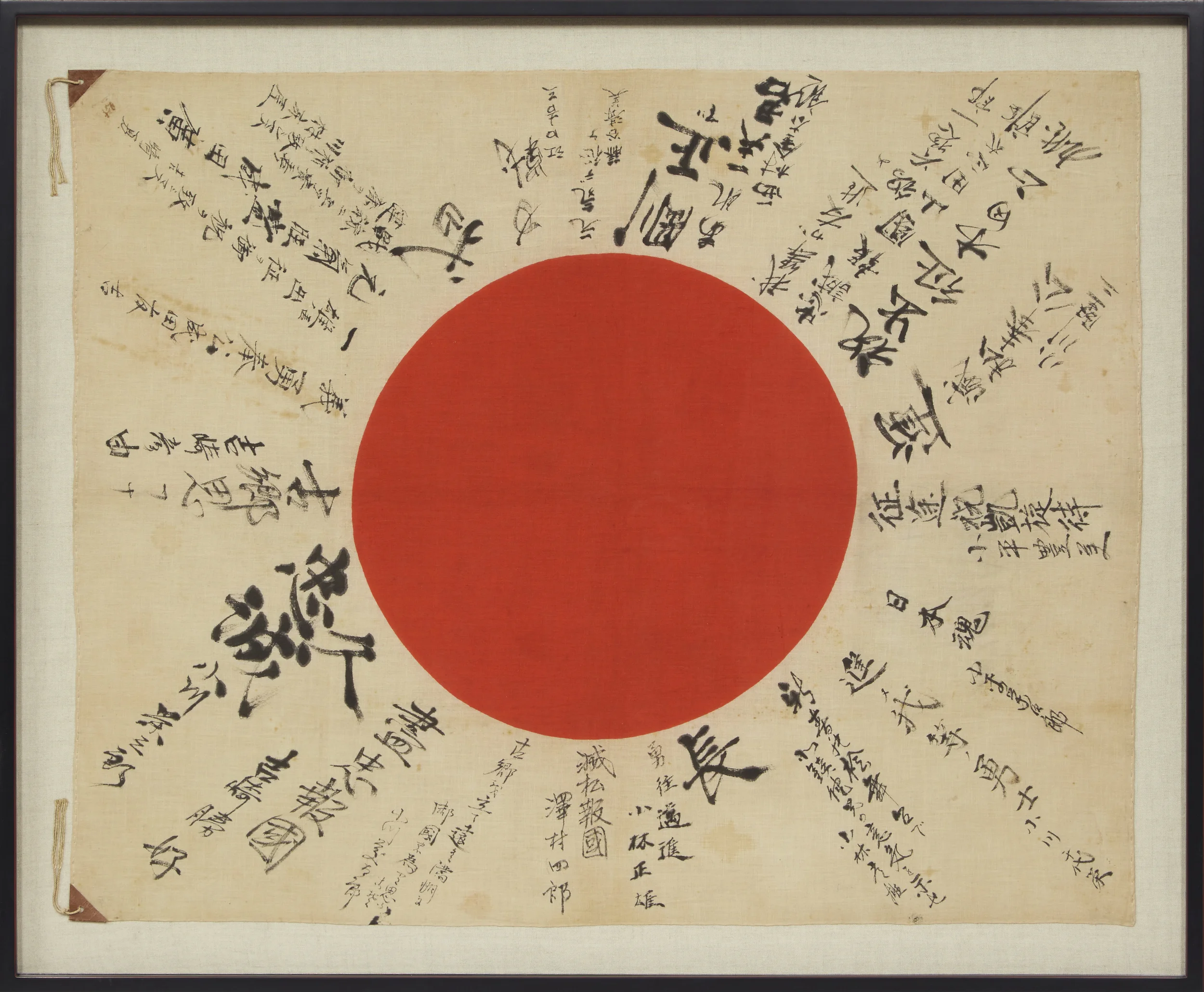Traditional and simple, yet beautifully constructed, the style of this Shaker bonnet may lead you to think that it is at least a hundred years old, if not more. Though reminiscent of styles popular in the mid 1800s, according to the owner, “This bonnet belonged to one of the last surviving Shaker sisters at the Canterbury Shaker Village in Canterbury, New Hampshire. It was sold after she passed away, many years ago.” The last Shakers at Canterbury Village might not have passed away as long ago as you think. Eldress Bertha Lindsay and Sister Ethel Hudson, the last two Shaker sisters at Canterbury Village, passed away in the early 1990s; only about 25 years ago.
Out of This World: The Tale of One Lucky Photograph
Here at The Center, we are used to seeing all sorts of artwork and family heirlooms come from worldwide locations, but we’ve never had an item come to us from out of this world! This particular story started off a little something like this…
The countdown began; ten, nine, eight, seven. The family watched as the space shuttle was about to lift from the launch pad; three, two, one, Blast Off!
Weathered Sculptures
The name may not be immediately familiar, but anyone who has spent time walking through the streets of Chicago, will likely recognize the distinctive figurative sculptures of Chicago artist John “Jack” Kearney (1924-2014). Kearney’s sculptures, like those in Oz Park, Chicago, capture a playfulness not always found with public artwork. Kearney trained at the Cranbrook Academy of Art in Bloomfield Hills, Michigan and later at Universita per Stranieri in Perugia, Italy. He became interested in creating artwork using a unique yet common material: chrome automobile bumpers. When his interest sparked in the 1950s, these materials were plentiful, durable, and added an unexpected element to his whimsical animal sculptures.
Norman Lewis, Abstract Expressionist
During the progressive early-mid 20th Century, the genre of Abstract Expressionism became a wildly popular timeperiod in American art history. New York School, as some called the movement, was a way for artists to break traditional and social conventions surrounding the art world, and adopt more emotional expression through abstraction. Among the list of Abstract Expressionist artists was Norman Lewis.
Displaying Waterbodies: A Look into Conservation Collaboration with former Chicago Bear, Israel Idonije
It seemed like any other Wednesday in September at The Center. Things were relatively quiet after a previously hectic week at EXPO CHICAGO, and the Client Services team was expecting an appointment with Israel Idonije who had a large watercolor piece that needed display options. When the client arrived with the watercolor, the team quickly realized that “display options” was an understatement. The Conservation Center prides itself on interdepartmental collaboration and the consultation soon included several conservators from many departments, all of whom were ready to Bear Down and tackle the task at hand.
A Six-Panel Screen and a Panel of Conservators
Whether ancient, contemporary, or any time in between, there are countless types of artwork of all styles and ages that challenge conservators. Every piece of artwork has its own nuances and characteristics that are the result of the artist’s technique, the materials used, and the conditions the artwork experiences over the years. When it comes to conservation there is probably no type of artwork as commonly complex as traditional Asian screens. Typically constructed of paper decorated with paints, gilding, and stretched over a wooden support, Asian screens are a type of object that can require consultations including conservators in many different specialties. Collaboration between paper, furniture, painting, and gilding conservators can be critical to determine the appropriate treatment and achieve successful results when treating Asian screens.
Yosegaki Hinomaru: The Good Luck Flag
Made of delicate fibers, folded, and carried in the pockets of soldiers, Japanese “good luck flags”, commonly known in Japan as yosegaki hinomaru, were parting gifts for soldiers deployed into battle. These flags are evidence of a long standing tradition among Japanese servicemen. The Japanese National Flag, commonly known in Japan as hinomaru, was used to facilitate these messages of prayers and well-wishes from loved ones, so that the soldier could endure the difficult times ahead; yosegaki, refers to the gathered writing, often inscribed in a pattern radiating from the center of the flag. A yosegaki hinomaru experienced only a fraction of the harrowing perils of war experienced by the soldiers who carried them to the front lines. It is remarkable that these flags have survived to continue the story of the soldiers who brought them into battle.
Not Made to Last: A Look at Advertising Banners
Much like newspapers, advertising materials have a definite and distinct shelf-life. Products come and go, and for those companies that do stick around for many years, marketing slogans and styles will change with the times, thus deeming periodic updates to advertising campaigns a necessity. As a result, vintage advertising materials were not made to last for very long: they were constructed with low cost materials and quick reproduction methods that make their survival a rarity. That’s why it is so astounding when items like these banners make it decades remarkably intact. Here’s a look at four advertising banners that have come through the doors at The Center over the years.
Conservation Station: A Behind the Scenes Look at The Conservation Center
When Lake Michigan was Lac des Puans: The Cartographic Origins of the Great Lakes
When Greg brought his map into The Center, he wasn’t seeking conservation work - the map was already in great condition. What it needed was quality framing to properly display it in Greg’s home and keep it safe for another 373 years. That’s right - dating back to 1643, this map of the Great Lakes by Jean Boisseau may not be helpful for travel these days, but will take you on an interesting trip to the past.
Contemporary Conservation and Surreal Artwork: The treatment of two Pedro Friedeberg Sculptures
When asked to describe conservation work, most people think of old discolored paintings and fine art prints with stains and tears - items that need to be treated for decades or even centuries of damage. But time is not a prerequisite for conservation treatment. The reality is that at The Conservation Center, contemporary items arrive at our doors everyday in need of treatment. Recently we had the pleasure of treating two contemporary, functional items by Surrealist artist Pedro Friedeberg.
Ask The Conservators: Does conservation-level framing really make a difference?
Will custom, conservation-level framing really make a difference with my artwork? What about the those low-cost, pre-made frames that come with their own mats and glass - won’t they get the job done?
Saving Superman
When Joe went down into the basement of his girlfriend’s house to repair a leaking pipe, he would have never guessed that within hours he would be at The Conservation Center’s doors with a striking, but severely deteriorated, painting of Superman in hand. It was wet, stained, moldy, and even had insects living behind the frame. Fortunately, The Center’s team was at the ready to stop this kryptonite before it could do its worst.
The Christmas Tricycle
As we move through the holiday season, our focus turns to family dinners, quiet snowfalls, and the joyful challenge of finding the perfect gift; the gift that will be treasured for years to come. And when the years take their toll on those items, we here at The Conservation Center consider it a special privilege to help in preserving those family treasures. This holiday season, we share with you an item brought to The Center by Mary, who reached out to see if it would be possible to restore one of her favorite childhood Christmas gifts: a circa 1964 Murray tricycle.
Oak Park Snow Scene
Although Chicago may be without the standard layer of snow for this time of the year, we here are The Conservation Center are lucky enough to have beautiful images around to remind us of a pristine snowfall. A client recently brought in just such a painting, though it wasn’t quite the impeccable snow scene it once was. Years of grime build-up and thick, discolored varnish had turned the crisp white snowfall into a dingy, brown landscape. But with some time, patience, and careful chemistry, Senior Paintings Conservator Amber Smith was able to bring the original colors back to this Oak Park snow scene.
A Day in the Life
A Stitch in Time
When extraordinarily fragile pieces are treated by The Center, often the conservators recommend handling the pieces as little as possible to preserve their longevity. So when Gloria Diaz brought in a delicate lace mantilla and expressed that she would like it to be functional for future ceremonies, we knew we had our work cut out for us.
At the time Gloria brought in her mantilla, it had been used by three generations in twenty-four weddings, ten baptisms, on “Taking of the Veil,” and one First Communion. Since the lace garment had been both well-loved and well-used, it exhibited inevitable signs of wear. As Gloria noted, “I realized that the mantilla was near the end of its life if we did not do something to improve its condition. Because of its special place in our family, we wanted the mantilla to be something that existing and future generations would use.”
A Note from Heather Becker, CEO
On November 13th, I gave a presentation on disaster preparedness at the Association of Registrars and Collection Specialists (ARCS) conference in New Orleans. The audience included nearly 700 museum registrars, collection managers, conservators, consultants, appraisers, and art shippers.
Common Culprits of Damage: Causation and Prevention 101
Given The Conservation Center’s history of treating artworks that have succumbed to fire and flood damage, it may surprise you to know that a few of the most common culprits of damage are poor materials, framing, and storage techniques. Luckily, with proper foresight and preparation, most of this damage is preventable. In this article we will examine some of the common "red flags" to look for in consideration of your own framed art and heirlooms.
Proud to be an American: Preserving "Regulations for the Army of the United States, 1913"
The Conservation Center recently had the pleasure of working with Bill Hartel to treat “Regulations for the Army of the United States,” a 1913 U.S. Army military handbook.
Bill is an avid collector of rare books and acquires those that, in his opinion, “changed the world.” Highlights of his collection include a 1776 British first edition of Thomas Paine’s “Common Sense,” complete with handwritten defamatory comments about King George, and “Round the Moon” by Jules Verne, circa 1895, signed by the commander of the first actual voyage around the moon, Frank Borman. Bill is also an author and published the Chicago Tribune Best Seller “A Day at the Park” about Wrigley Field. Given the depth of his collection, a well-worn copy of an army handbook with a missing leather spine, fragile textblock, and water damage may seem like an anomaly. However, the book’s value lies in the role it played during a difficult time in Bill’s life.





















